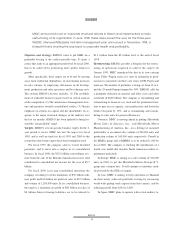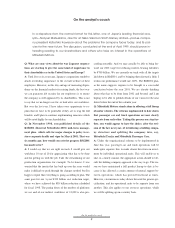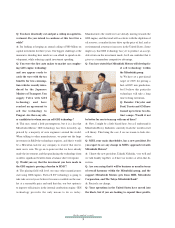Mitsubishi 1999 Annual Report Download - page 18
Download and view the complete annual report
Please find page 18 of the 1999 Mitsubishi annual report below. You can navigate through the pages in the report by either clicking on the pages listed below, or by using the keyword search tool below to find specific information within the annual report.
air conditioning systems that have cut HFC134a quantities
by 20%. The company is working to reduce the quantity of
lead used to under a half the 1996 level in 2000-model year,
and to under a third in 2005-model year, cars.
Alternative energy vehicles
MMC is actively working towards two principal objectives
in the field of alternative energy vehicles: (1) Developing
cleaner power and, (2) Finding alternative to diminishing
fossil fuel reserves.
Electric vehicles are virtually pollution free, but are
handicapped by restricted cruising range and high prices due
to low production volumes. Hybrid propulsion systems sig-
nificantly reduce emissions over gasoline or diesel engines
MMC has market-ready technology that has been part of the
California Air Resource Board testing program since 1995.
The company has developed advanced high-power lithium-
ion batteries that are lighter and have a longer useful life, and
high-efficiency energy management systems for EV and
HEV use.
The GDI SIGMA Series powertrain announced this year
utilizes the superior starting and response characteristics of
GDI technology to give 10-30% better mileage, better drive-
ability and lower costs, by marrying the GDI engine with
continuously variable transmission, idle-stop, turbocharging,
and HEV technologies. (See page 19)
The fuel cell, which generates energy through the hydro-
gen-oxygen reaction, promises a very clean source of energy
for electric vehicles. MMC is currently working on develop-
ment of this exciting technology with Mitsubishi Heavy
Industries, the world-leader in the field, with Mitsubishi
Electric and with other members of the Mitsubishi group.
The company expects to complete the first prototype by
2000, a road-test vehicle by 2001 and to start prototype pro-
duction in 2005.
Vehicles using CNG fuel produce 30% less CO2than
gasoline, and none of the particulate matter associated with
diesel vehicles. MMC currently markets several CNG mod-
els, ranging from minicars to city buses, and will continue to
expand this range.
Environmental stewardship at MMC extends beyond the mo-
tor vehicles it produces. Stringent internal standards govern
energy and water use, waste generation and the recycling of
plastic and metal scraps at all production facilities and make
Environment
16
Reformer
HydrogenPower
Air
Fuel tankFuel cell
Motor
Environmental stewardship: production facilities
Systematic representation of MMC fuel cell EV
























